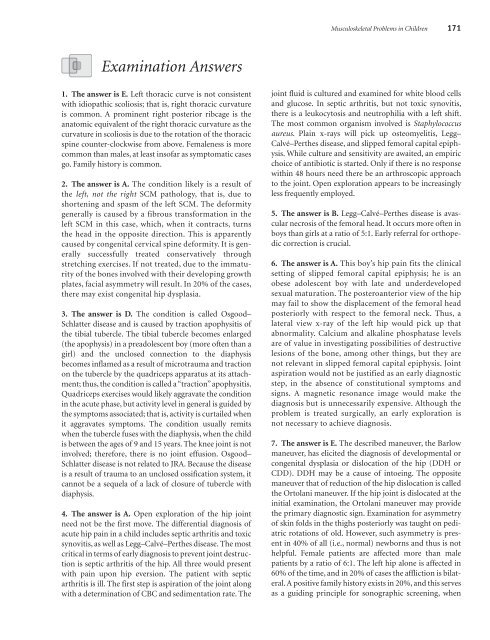NMS Q&A Family Medicine
NMS Q&A Family Medicine
NMS Q&A Family Medicine
- No tags were found...
You also want an ePaper? Increase the reach of your titles
YUMPU automatically turns print PDFs into web optimized ePapers that Google loves.
Musculoskeletal Problems in Children 171Examination Answers1. The answer is E. Left thoracic curve is not consistentwith idiopathic scoliosis; that is, right thoracic curvatureis common. A prominent right posterior ribcage is theanatomic equivalent of the right thoracic curvature as thecurvature in scoliosis is due to the rotation of the thoracicspine counter-clockwise from above. Femaleness is morecommon than males, at least insofar as symptomatic casesgo. <strong>Family</strong> history is common.2. The answer is A. The condition likely is a result ofthe left, not the right SCM pathology, that is, due toshortening and spasm of the left SCM. The deformitygenerally is caused by a fibrous transformation in theleft SCM in this case, which, when it contracts, turnsthe head in the opposite direction. This is apparentlycaused by congenital cervical spine deformity. It is generallysuccessfully treated conservatively throughstretching exercises. If not treated, due to the immaturityof the bones involved with their developing growthplates, facial asymmetry will result. In 20% of the cases,there may exist congenital hip dysplasia.3. The answer is D. The condition is called Osgood–Schlatter disease and is caused by traction apophysitis ofthe tibial tubercle. The tibial tubercle becomes enlarged(the apophysis) in a preadolescent boy (more often than agirl) and the unclosed connection to the diaphysisbecomes inflamed as a result of microtrauma and tractionon the tubercle by the quadriceps apparatus at its attachment;thus, the condition is called a “traction” apo physitis.Quadriceps exercises would likely aggravate the conditionin the acute phase, but activity level in general is guided bythe symptoms associated; that is, activity is curtailed whenit aggravates symptoms. The condition usually remitswhen the tubercle fuses with the diaphysis, when the childis between the ages of 9 and 15 years. The knee joint is notinvolved; therefore, there is no joint effusion. Osgood–Schlatter disease is not related to JRA. Because the diseaseis a result of trauma to an unclosed ossification system, itcannot be a sequela of a lack of closure of tubercle withdiaphysis.4. The answer is A. Open exploration of the hip jointneed not be the first move. The differential diagnosis ofacute hip pain in a child includes septic arthritis and toxicsynovitis, as well as Legg–Calvé–Perthes disease. The mostcritical in terms of early diagnosis to prevent joint destructionis septic arthritis of the hip. All three would presentwith pain upon hip eversion. The patient with septicarthritis is ill. The first step is aspiration of the joint alongwith a determination of CBC and sedimentation rate. Thejoint fluid is cultured and examined for white blood cellsand glucose. In septic arthritis, but not toxic synovitis,there is a leukocytosis and neutrophilia with a left shift.The most common organism involved is Staphylococcusaureus . Plain x-rays will pick up osteomyelitis, Legg–Calvé–Perthes disease, and slipped femoral capital epiphysis.While culture and sensitivity are awaited, an empiricchoice of antibiotic is started. Only if there is no responsewithin 48 hours need there be an arthroscopic approachto the joint. Open exploration appears to be increasinglyless frequently employed.5. The answer is B. Legg–Calvé–Perthes disease is avascularnecrosis of the femoral head. It occurs more often inboys than girls at a ratio of 5:1. Early referral for orthopediccorrection is crucial.6. The answer is A. This boy’s hip pain fits the clinicalsetting of slipped femoral capital epiphysis; he is anobese adolescent boy with late and underdevelopedsexual maturation. The posteroanterior view of the hipmay fail to show the displacement of the femoral headposteriorly with respect to the femoral neck. Thus, alateral view x-ray of the left hip would pick up thatabnormality. Calcium and alkaline phosphatase levelsare of value in investigating possibilities of destructivelesions of the bone, among other things, but they arenot relevant in slipped femoral capital epiphysis. Jointaspiration would not be justified as an early diagnosticstep, in the absence of constitutional symptoms andsigns. A magnetic resonance image would make thediagnosis but is unnecessarily expensive. Although theproblem is treated surgically, an early exploration isnot necessary to achieve diagnosis.7. The answer is E. The described maneuver, the Barlowmaneuver, has elicited the diagnosis of developmental orcongenital dysplasia or dislocation of the hip (DDH orCDD). DDH may be a cause of intoeing. The oppositemaneuver that of reduction of the hip dislocation is calledthe Ortolani maneuver. If the hip joint is dislocated at theinitial examination, the Ortolani maneuver may providethe primary diagnostic sign. Examination for asymmetryof skin folds in the thighs posteriorly was taught on pediatricrotations of old. However, such asymmetry is presentin 40% of all (i.e., normal) newborns and thus is nothelpful. Female patients are affected more than malepatients by a ratio of 6:1. The left hip alone is affected in60% of the time, and in 20% of cases the affliction is bilateral.A positive family history exists in 20%, and this servesas a guiding principle for sonographic screening, when
















